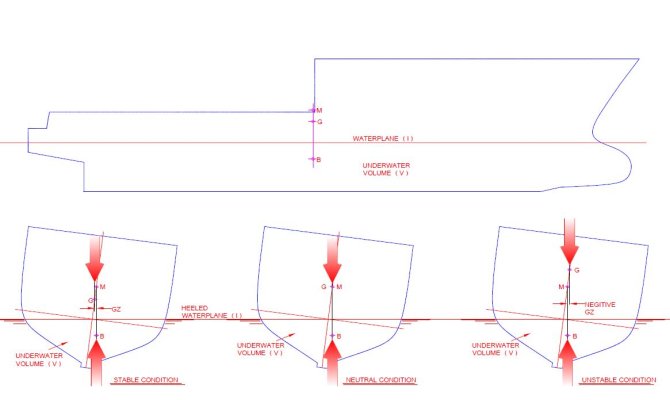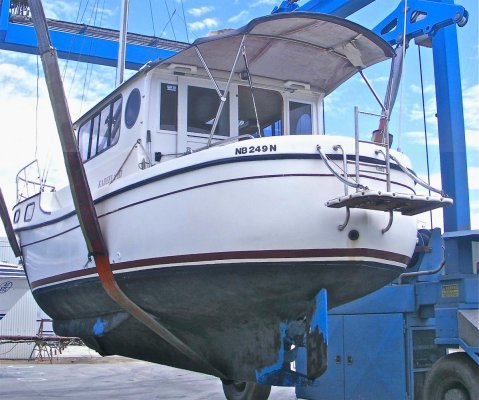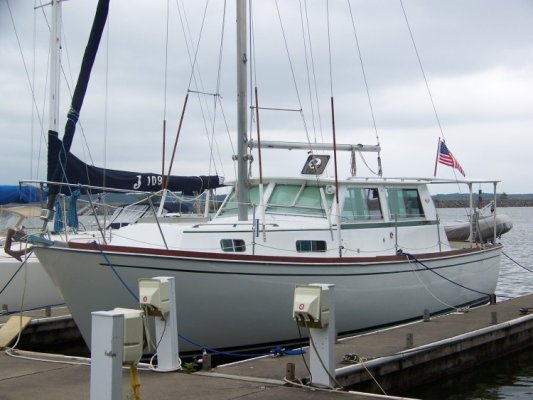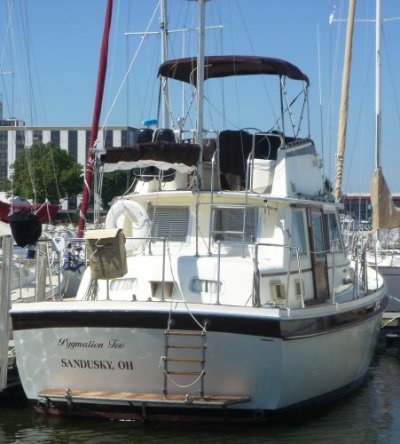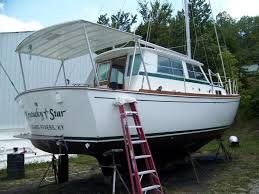Al
Guru
- Joined
- Apr 1, 2012
- Messages
- 2,206
- Location
- usa
- Vessel Name
- 'SLO'~BELLE
- Vessel Make
- 1978 Marben-27' Flybridge Trawler(extended to 30 feet) Pilothouse Pocket Cruiser[
Dannc-
Thank you, I did in deed read the article. I assume you read my more detailed response to Martin regarding why, how, how much and where we placed our ballast.
Had I read this article before doing what we did, I suspect that I would hesitate and quandary a bit more prior to making a move. Yet, the results we obtained with what we did are amazing in terms of settling the boat down. Honest, were I to be occupied in the boat and unannounced you stepped on the gunnels, the action would throw me off my feet! In a beam sea, ;you could not sit on the helm chair without rotating 90 degrees with the sharp rolling motion. We have a FD hull, not a SD or flat bottom. I agree with the conclusions of actions apparent with sharp chine boats, I have had several. In our FD hull the roll was a roll, a very quick roll, not the snap roll as described. Yes, I in adversely used the term “Snap” in my response where it should have been “Quick”. In a head sea due to the shortness of the hull (27’ WL) our local sea distance cap to cap, are more suited for a 36 foot boat or longer. So we “Hobby Horse” to a degree,
Prior to the adding of ballast that action would throw you out of the helm chair, back and forth. Let me say that at that point I wondered if the purchase of the boat was a huge mistake. I wondered back if the prior owners became dissatisfied with the action and did sell the boat to move it along as there had never been any effort to address in the format we invested.
The bottom line is with the majority of the 1100# weight added, dead center over the already built in 1500# led cast in the keel when constructed, with remaining ingots located abeam of the engine stringers and 100# located under the anchor chain. In addition, we shifted our three bank of batteries from mid-ship port side of the engine stringer to forward center line engine compartment bulkhead (90#?) the boat now lifts and falls with a noted softness over the original harshness.
The boat handles beam seas in a almost vertical position with the waves running under the boat and not slapping the boat over. Yes, on the stern wave action we are still looking much the drunken sailor but not with the added quick roll, more the reaction is a lighter slower heeling. More a rudder battle over a hull swerving action. Does that seem a clear picture? Our roll is soft, our hobby horse is reduced and the boat is a more pleasant motion in our common 2 foot seas. (Note: when the seas exceed 2 feet, in any case we are looking for a hidey hole.
As to the effects of adding weight per the article, we recently increased the hp of the engine with a repower, noted in several recent post. Our hull seed is 6.9 knots and with the calculated weight of the boat including all ballast and such, only 34 hp are required to reach hull speed. So the power sector of the article as it relates to our small boat is nil.
WE don’t push much water as we are about maxed out for efficiency at 1400 RPM and at hull speed so the concerns of extra weight are again in my opinion nil.
Please understand that I am wanting to be argumentative in the discussion rather I draw a different conclusion in light of actual physical application that runs contrary to the article in so many ways.
As I type this response, sitting in the Wrangell boat harbor, I am witnessing several commercial fishing boats that have installed tanks to accommodate fish quality. The boat tanks are flooded to the point that the water is flowing over the decks and off. Can you imagine what a say 20 foot long hold, say 15 feet wide and say, 8 feet deep water contained weighs and what does that do for the discussion of ballast placement? And yes, these boats are running in heavy seas at times in full tank conditions. Don’t want to change the thread, but those conditions I described run contrary to the authors article I would think.
Perhaps Tad Roberts being a marine architect would present a response to why I am having success in face of the article and the conclusions of having commercial boats tanked affecting stability rules
Al
Thank you, I did in deed read the article. I assume you read my more detailed response to Martin regarding why, how, how much and where we placed our ballast.
Had I read this article before doing what we did, I suspect that I would hesitate and quandary a bit more prior to making a move. Yet, the results we obtained with what we did are amazing in terms of settling the boat down. Honest, were I to be occupied in the boat and unannounced you stepped on the gunnels, the action would throw me off my feet! In a beam sea, ;you could not sit on the helm chair without rotating 90 degrees with the sharp rolling motion. We have a FD hull, not a SD or flat bottom. I agree with the conclusions of actions apparent with sharp chine boats, I have had several. In our FD hull the roll was a roll, a very quick roll, not the snap roll as described. Yes, I in adversely used the term “Snap” in my response where it should have been “Quick”. In a head sea due to the shortness of the hull (27’ WL) our local sea distance cap to cap, are more suited for a 36 foot boat or longer. So we “Hobby Horse” to a degree,
Prior to the adding of ballast that action would throw you out of the helm chair, back and forth. Let me say that at that point I wondered if the purchase of the boat was a huge mistake. I wondered back if the prior owners became dissatisfied with the action and did sell the boat to move it along as there had never been any effort to address in the format we invested.
The bottom line is with the majority of the 1100# weight added, dead center over the already built in 1500# led cast in the keel when constructed, with remaining ingots located abeam of the engine stringers and 100# located under the anchor chain. In addition, we shifted our three bank of batteries from mid-ship port side of the engine stringer to forward center line engine compartment bulkhead (90#?) the boat now lifts and falls with a noted softness over the original harshness.
The boat handles beam seas in a almost vertical position with the waves running under the boat and not slapping the boat over. Yes, on the stern wave action we are still looking much the drunken sailor but not with the added quick roll, more the reaction is a lighter slower heeling. More a rudder battle over a hull swerving action. Does that seem a clear picture? Our roll is soft, our hobby horse is reduced and the boat is a more pleasant motion in our common 2 foot seas. (Note: when the seas exceed 2 feet, in any case we are looking for a hidey hole.
As to the effects of adding weight per the article, we recently increased the hp of the engine with a repower, noted in several recent post. Our hull seed is 6.9 knots and with the calculated weight of the boat including all ballast and such, only 34 hp are required to reach hull speed. So the power sector of the article as it relates to our small boat is nil.
WE don’t push much water as we are about maxed out for efficiency at 1400 RPM and at hull speed so the concerns of extra weight are again in my opinion nil.
Please understand that I am wanting to be argumentative in the discussion rather I draw a different conclusion in light of actual physical application that runs contrary to the article in so many ways.
As I type this response, sitting in the Wrangell boat harbor, I am witnessing several commercial fishing boats that have installed tanks to accommodate fish quality. The boat tanks are flooded to the point that the water is flowing over the decks and off. Can you imagine what a say 20 foot long hold, say 15 feet wide and say, 8 feet deep water contained weighs and what does that do for the discussion of ballast placement? And yes, these boats are running in heavy seas at times in full tank conditions. Don’t want to change the thread, but those conditions I described run contrary to the authors article I would think.
Perhaps Tad Roberts being a marine architect would present a response to why I am having success in face of the article and the conclusions of having commercial boats tanked affecting stability rules
Al

